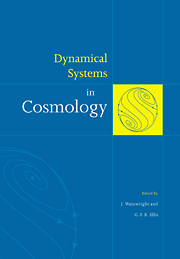Book contents
- Frontmatter
- Contents
- List of contributors
- Preface
- Introduction
- Part one Background
- Part two Spatially homogeneous cosmologies
- 5 Qualitative analysis of Bianchi cosmologies
- 6 Bianchi cosmologies: non–tilted class A models
- 7 Bianchi cosmologies: non–tilted class B models
- 8 Bianchi cosmologies: extending the scope
- 9 Exact Bianchi cosmologies and state space
- 10 Hamiltonian cosmology
- 11 Deterministic chaos and Bianchi cosmologies
- Part three Inhomogeneous cosmologies
- Part four Conclusion
- References
- Subject index
11 - Deterministic chaos and Bianchi cosmologies
Published online by Cambridge University Press: 10 November 2009
- Frontmatter
- Contents
- List of contributors
- Preface
- Introduction
- Part one Background
- Part two Spatially homogeneous cosmologies
- 5 Qualitative analysis of Bianchi cosmologies
- 6 Bianchi cosmologies: non–tilted class A models
- 7 Bianchi cosmologies: non–tilted class B models
- 8 Bianchi cosmologies: extending the scope
- 9 Exact Bianchi cosmologies and state space
- 10 Hamiltonian cosmology
- 11 Deterministic chaos and Bianchi cosmologies
- Part three Inhomogeneous cosmologies
- Part four Conclusion
- References
- Subject index
Summary
It is well known that solutions of non–linear differential equations in three and higher dimension can display apparently random behaviour referred to as deterministic chaos, or simply, chaos. The associated dynamical system is then referred to as being chaotic. It was recognized some years ago that the oscillatory approach to the past or future singularity of Bianchi IX vacuum models displays random features (e.g. Belinskii et al. 1970, which we shall refer to as BKL, and Barrow 1982b), and hence is a potential source of chaos. This oscillatory behaviour is also believed to occur in other classes of models, provided that the Bianchi type and/or source terms are sufficiently general (see Sections 8.1 and 8.4). The goal in this chapter is to address the question of whether the dynamical systems which describe the evolution of Bianchi models are chaotic.
Historically, both Poincaré and Birkhoff in the late nineteenth and early twentieth centuries were aware that non–linear DEs could admit complicated aperiodic or quasi–periodic solutions. The modern development of a theory of chaotic dynamical systems was stimulated in a large part by two papers, namely Lorenz (1963), a numerical simulation of a three–dimensional DE, and Smale (1967), a theoretical analysis of discrete dynamical systems. The field developed rapidly once computer simulations of dynamical systems became widely available. Despite a lengthy history, complete agreement on a definition of chaotic dynamical system has not been reached.
Information
- Type
- Chapter
- Information
- Dynamical Systems in Cosmology , pp. 229 - 246Publisher: Cambridge University PressPrint publication year: 1997
